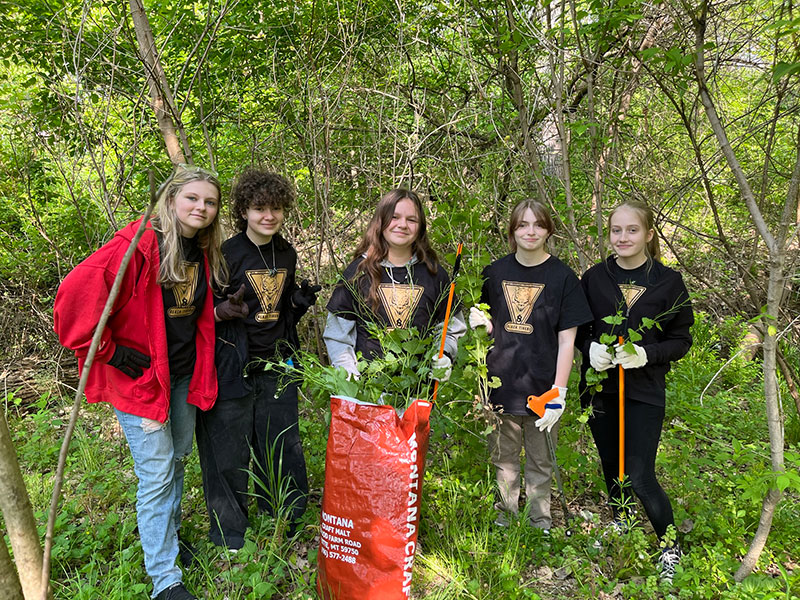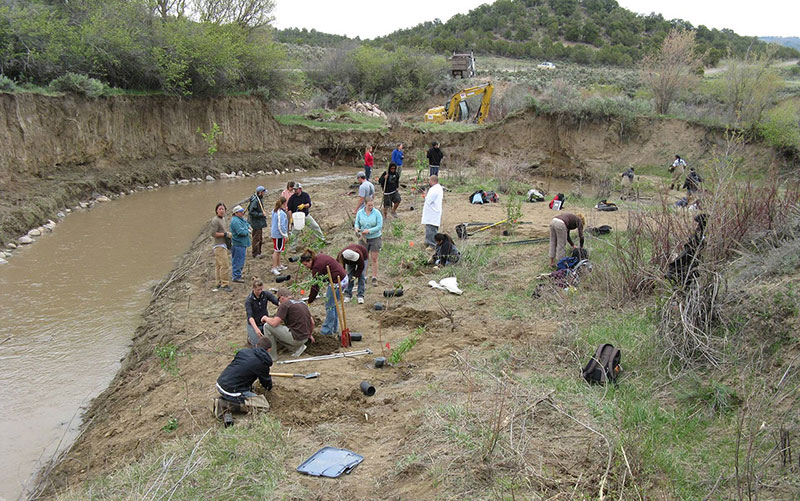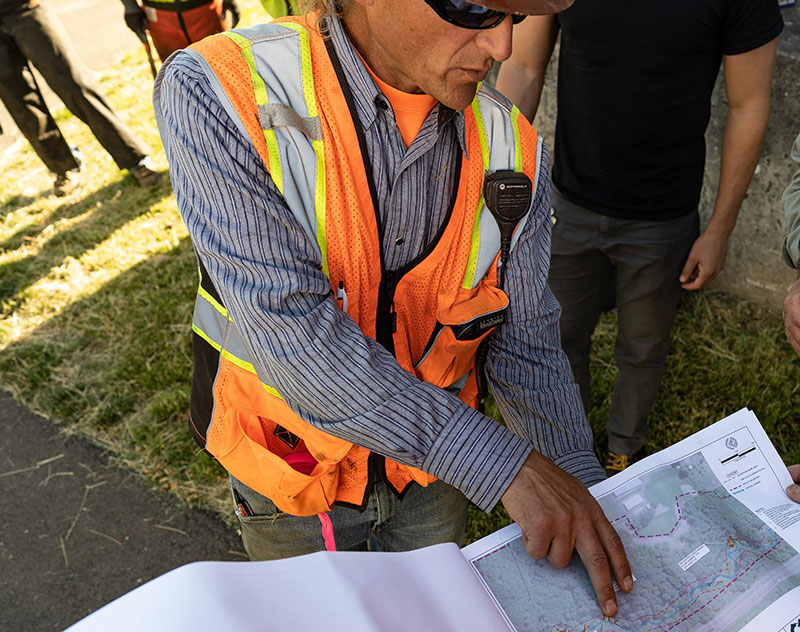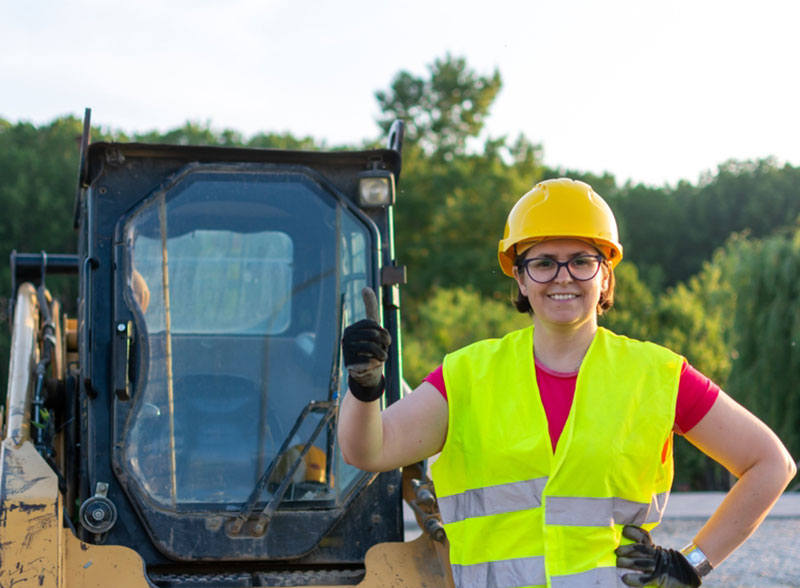Nature Needs Design-Build
By Keith Bowers, RLA, FASLA, PWS

The backhoe bucket swung around and began to dig. As the teeth dug deep into the soil, a loud, screeching noise sprung from the ground, followed by a billowing cloud of rock dust that waffed in the air around the half-dug hole. The backhoe operator didn’t need to be told what had just happened. She had seen this before. An unexpected vein of solid rock coursed through the ground right where a forebay was to be placed for a stormwater wetland. Jane looked around and studied her options. She could shift the forebay to either side but that meant taking out groves of trees that had been specifically set aside and protected for their habitat value. It would also mean reconfiguring the flow path between the forebay and the primary wetland treatment area. Alternatively, she could move the forebay back behind the rock vein, but that would require substantial realignment of the inflow channel and possible redesign of the wetland area to provide the required water quality treatment. Whatever needed to be done would require a good idea of the cascading effects the decision might have on the ultimate success of the project, including potential additional costs and construction time.
Jane wasn’t worried though. This was a design-build project and she had been through similar situations before. Better still, she had been involved in the design process and had a good sense of what would be required to minimize redesign, limit construction downtime, and enable the project to meet all of its performance goals. The next morning, she gathered the design team on-site to walk through options.
If you’ve ever been involved with the construction of a nature-based solution you know that unexpected field challenges, such as the one encountered by Jane, can spring up at any time.
I have been a strong proponent of the design-build delivery system my entire career. Having spent my summers through college working for plant nurseries and landscape contractors, and a decade after school working in the field as an ecological restoration contractor, I developed both a love and a respect for what it takes to work with living systems. I learned quickly that the complexity and unpredictability of nature can never be fully captured at the design table. All the specifications and design details in the world could never account for all the nuances encountered in natural systems.

Nature-based design is about harnessing the innate power of nature to restore ecosystem functions, enhance biodiversity, and increase climate resiliency. It requires us to apply ecological principles to create, produce, manufacture, and build conditions that are not only conducive to life, but are life. Not just human life, but the full array of more than human life that exists on this planet. The beauty of applying nature-based solutions is that they strengthen and become more resilient with age; they continue to evolve and regenerate over time. This is in stark contrast to conventional construction that relies solely on inert materials, where project components begin to degenerate the minute they are installed. Practicing nature-based design requires a solid understanding of the life and earth sciences and a recognition that we have barely scratched the service of what there is to know about how nature works.
Try as we may to move nature-based design toward more conventional engineering and architecture standards, we can only go so far before nature humbles us back into submission. I suspect like any gardener, I also learned that working in nature requires us to gain a certain intuitive sense of what is happening on the ground and attain the subtle finesse it takes to nudge nature to function in accordance with our best intentions. Working with our hands, toiling in the soil, planting a tree, installing a root wad, erecting a dead snag, sowing seed, pulling weeds, or even sculpting a coral reef analog using 3-D printing, provides an opportunity to become thoroughly immersed in the very thing we are coveting–life. It provides a way of knowing that we don’t get sitting behind a computer screen or directing from the sidelines.
“Working with our hands…provides a way of knowing that we don’t get sitting behind a computer screen or directing from the sidelines.”
Nature-based projects demand the flexibility to pivot, adopt, and adapt along a time continuum that doesn’t necessarily follow conventional construction and maintenance practices. For example, optimum planting times are often predicated on biological cycles, weather, and soil conditions; construction activities may be subjected to time-of-year restrictions to protect critical species; and management requirements may depend on annual migration patterns. Sometimes time can be a friend in constructing a nature-based project. Other times it can radically change baseline conditions or reveal previously unimagined stressors to the system. A seasoned design-build team can react swiftly, accurately assessing the situation and moving forward with well-informed changes to construction that won’t compromise the design intent and ecological integrity of the project. To pivot, adopt, and adapt within a conventional design-bid-build delivery system is hard without incurring prolonged delays, increased costs, and occasional finger pointing. Since nature is constantly evolving and changing, I have found that preparing an adaptive management plan as part of the design-build process is key to successfully implementing a pivot, adopt, and adapt approach.

I understand that not everyone can be proficient at developing a design package and jumping on a backhoe to grade a series of wetland hummocks or grabbing a dibble to plant thousands of emergent grasses. I do know that designers and construction contractors can work hand-in-hand, in a thoroughly integrated fashion, to seamlessly deliver a project that leverages that innate way of knowing a natural system that is so important for the success of a nature-based approach. Based on my experience, the best way to do this is through a progressive or integrated design-build model.
What I have also come to appreciate about the design-build delivery system is its flexibility and capacity to deepen engagement and learning opportunities for nature-based projects. The simplicity of the design-build process provides opportunities for greater community engagement and participation throughout the design-build process. For example, the design-builder can more readily accommodate community and key stakeholder participation early in the design process and carry that involvement through construction and post construction activities. This type of commitment not only generates a deeper, reciprocal, and more transparent relationship between the community and the design-builder, it also can instill a deeper sense of community pride in the project outcome. I have been a part of design-build projects that engage communities in a variety of ways, like helping to gather field data, sharing stories, providing historical context, crafting design scenarios, curating plant species, removing invasive species, and participating in post-construction monitoring and maintenance.

Of course, we shouldn’t assume that community engagement is synonymous with volunteerism. To the contrary, communities and key stakeholders bring much needed value to a project and should be compensated accordingly. Nature-based projects are inherently place-based, and they should support local livelihoods and cultural traditions. With design-build, these activities can be easily assimilated into a cohesive and coordinated strategy. What I also love about this deeper engagement is the ability to put into practice the idea of ecological democracy, where we cede self-determination to the community and reinforce our collective responsibility to nature and the interconnectedness with all the more than human species. Indigenous communities know this already.

One feature of the design-build model that I love is the open, fluid sharing of knowledge it fosters. The perpetual communication back and forth between the construction crews and the design team enables valuable conversations like, ”This is why we designed it this way.,” or ”Here’s why that won’t work and this will,” or ”Wow, that makes sense.”
Nature is beautiful, but it’s also complex, non-linear, and often unpredictable. Add ongoing advances in our understanding of ecological and biological systems, our use of technology to design more complex systems, and our recognition of the value of indigenous knowledge, and it becomes more readily apparent that sharing knowledge throughout the design and construction process is essential for nature-based projects to thrive.
What is most exciting to me is that the design-build delivery system provides a platform for creativity and innovation. It makes one of my favorite questions—“What if?” —much less risky to ask. It allows the project team to experiment with different design approaches, try out alternative construction methods, or apply various management practices to learn what works best, and what elevates the quality of the work. Given all the variables that are encountered when designing a nature-based project, it can be enormously beneficial to experiment on a small scale first, monitor the outcomes, and then select the optimal method(s) going forward. This is the true essence of adaptive management: reducing uncertainty and risk through in-situ, real-time research.

With design-build, the relationship between the design team and the construction crew creates a legal framework that can facilitate adaptive management. Extending the design-build delivery system to design-build-manage opens additional opportunities to apply the adaptive management process throughout post construction activities, where project success is ultimately determined.
It makes one of my favorite questions—“What if?”—much less risky to ask.
For nature-based projects, the design-build delivery system fosters so many good things, even beyond the project outcome: research and learning opportunities, advancement of ecological democracy, and a sense of responsibility and long-term stewardship among the project team and community. I mean, just look at how things ended up with Jane…
As they peered into the test pits that Jane had excavated, the design-build team could see that the rock was there to stay. One of the designers asked Jane how difficult it would be to cut a notch in the rock. Jane replied that she could do so using a concrete cut-off saw.
“That’s great,” said the designer. “According to my calculations, we can cut a weir into the rock at the right elevation and eliminate the need to reroute the inflow channel. Plus, the weir can serve as a grade-control structure, minimizing potential head-cutting to the inflow channel and eliminating the need for a stone sill. And, based on the modeling we ran last night, we only need to make slight adjustments to the depths and shape of the wetland basin to accommodate the area that the rock would be displacing.”
Even though there were contingencies built into the contract, everyone agreed that any additional time and expense could be absorbed in the overall budget. Jane was back at work by mid-morning with minimal disruption and a clear idea of what had to be done to deliver a successful nature-based project.

